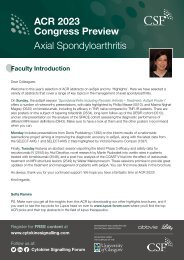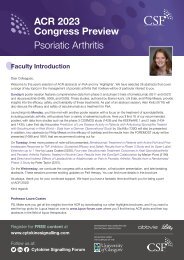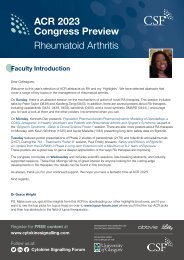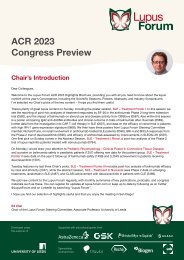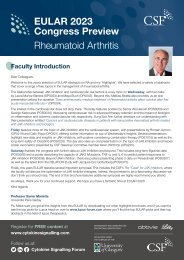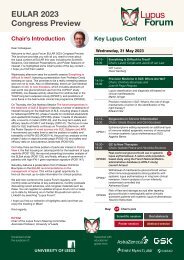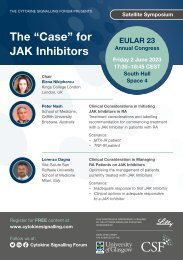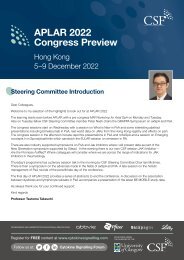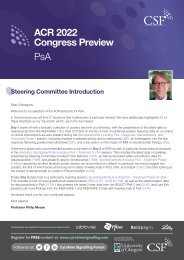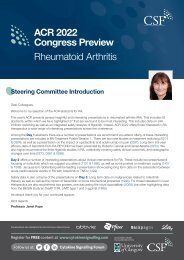EULAR 2018 Review
You also want an ePaper? Increase the reach of your titles
YUMPU automatically turns print PDFs into web optimized ePapers that Google loves.
interruption visit, AEs, SAEs and discontinuations due to AEs occurred in 54.4%, 11.1%<br />
and 1.5% of patients, respectively. The authors concluded that there was no loss of<br />
efficacy after temporary withdrawal of tofacitinib, and that the safety profile was consistent<br />
with that observed in previous LTE studies over 9 years [#0037].<br />
Malignancy and serious infection rates in clinical trials of JAK inhibitors for RA<br />
Lopez-Olivio, et al. presented a systematic review and meta-analysis of malignancies and<br />
serious infections during randomised controlled trials of JAK inhibitors in patients with RA.<br />
Thirty-one trials including 13 945 patients were included. Reported rates of malignancies<br />
across studies ranged from 0% to 2.0%, and rates of serious infections ranged from 0.7%<br />
to 5.4%. The most commonly reported malignancies were lung cancer, melanoma,<br />
nonmelanoma skin cancer (NMSC), basal cell and squamous cell carcinoma. Patients<br />
receiving the combination of JAK inhibitor plus MTX or JAK inhibitor monotherapy had<br />
numerically higher rates of malignancies, compared with MTX between 12 and 24 weeks<br />
before the rescue treatment was implemented (odds ratio [OR] 2.48, 95% confidence<br />
intervals [CI] 0.76–8.11 and OR 1.39, 95% CI 0.21–9.11, respectively). JAK inhibitor<br />
groups had similar rates of serious infections to those observed in the control groups.<br />
However, higher rates of serious infections were observed in patients receiving higher<br />
doses of JAK inhibitors [#0032].<br />
Abstract Session: Fires and firefighters: switching the immune system on and off<br />
Joint-specific differences in activation of the JAK-STAT pathway in RA<br />
Masterson and colleagues presented findings on substantial quantitative and qualitative<br />
differences in the JAK-STAT signalling pathway in synovial fluid (SF) from different joints.<br />
Using synovial fluid isolated from knee, shoulder and hand joints from patients with RA and<br />
osteoarthritis who were undergoing joint replacement surgery, the authors showed that the<br />
JAK-STAT pathway was enriched in knee SF versus hand and shoulder SF. Knee SF<br />
exhibited increased expression of JAK and STAT genes and enhanced signalling upon<br />
stimulation with IL-6/sIL-6R. The authors suggest that RA in different joints might not be<br />
equally sensitive to JAK-kinase inhibitors or blockade of IL-6, which has important<br />
implications for clinical practice and drug discovery in this therapy area [#0165].



